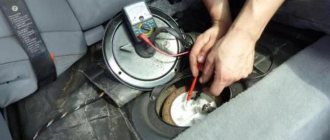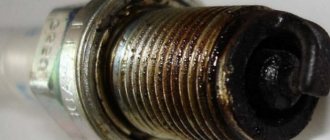Many drivers change consumables too late. The same applies to the car's transmission. In this article we will look at a fairly common problem for many car enthusiasts and tell you what to do if the clutch slips? But before considering the problem, let’s figure out what kind of part it is, what it is intended for and how do the symptoms of its failure manifest themselves?
Why is clutch needed?
The clutch is necessary to transmit torque from the engine flywheel to the intermediate shaft of the vehicle's gearbox. This is exactly the part that can limit or create the connection between the power plant and the transmission. The principle of operation of the clutch is based on the friction that occurs between two pressed discs. When you press the clutch pedal, the disc is released and the transmission of torque stops. When released, the disk is again pressed against the flywheel and then the intermediate shaft of the gearbox comes into operation.
Note for drivers
If you keep your foot on the clutch release pedal for a long time, then the clutch will quickly burn out and you will have to change it:
- This truism is often violated by new drivers.
- This does not happen due to forgetfulness, but simply driving a car with the clutch half depressed is more convenient and much easier
- That is why for most car enthusiasts, clutch failures became the reason for their first repair, a new car
- The clutch operation must be checked before each trip to a driving school, and the diagnostics performed often indicate the need for urgent repairs; malfunctions are usually associated with replacing friction discs
Why does the clutch fail?
The clutch disc is a consumable item and sooner or later still needs to be replaced. It is impossible to repair a worn disk. The fact is that when it comes into contact with the flywheel, it begins to grind down for a while and only then the parts interlock with each other. Thus, the thickness of the clutch decreases and eventually the disc loses its function.
You can also “grind off” the clutch in a quick way. Many drivers, when starting to move, press the gas too hard and at the same moment quickly release the clutch pedal. At these moments, clutch wear increases significantly and then it will need to be replaced quite soon. Rapid disc wear is also achieved by driving quickly in low gears. At that moment, when the speed is high and the gear is selected too low, the clutch does not have time to transmit the required torque to the intermediate shaft and begins to slip. Thus, it receives additional “unnecessary” friction and wears out quickly.
Another reason is that engine oil gets on the working part of the disk. The problem is quite rare, but it also occurs. The fact is that when the rear crankshaft oil seal wears out, oil leaks to the engine flywheel. The oil remains on the clutch surface and friction is reduced, thus causing the disc to “slip.”
Other faults and symptoms
Malfunctions in the mechanism can also be indicated by the following extraneous noises:
- So, for example, increased noise that appears when switching on indicates either a lubricant leak or wear of the release bearing. The bearing should be replaced immediately
- The noise that occurs when the clutch pedal is released tells us about a breakage or loss of elasticity of the damper springs, as well as the clutch fork spring, or breakage of the plates connecting the pressure plate to the housing
If your VAZ 2112 engine stalls when you press the clutch, get ready for serious repairs, there are several options and all of them are very unpleasant:
- Option one, something has broken in the clutch and the flywheel is jamming
- Option two, and more likely, but much less pleasant, since the cost of repairs will be higher
- There are bearings inside the engine block that prevent axial displacement of the crankshaft
- They look like a puck that has been cut in half. If they are old and very worn, or they were completely forgotten to install after repair, then the VAZ 2112 engine stalls when clutching, because the crankshaft moves forward, and the axial clearance disappears, and the entire crank mechanism warps, which slows down the crankshaft and the engine , of course, it stalls
- If the clutch pedal squeaks in a VAZ 2112, most likely this is caused by friction of the cable in the sheath, try lubricating it, if that doesn’t help, then only replacement
With clutch malfunctions, to find out how to fix them, we recommend watching the video material.
Signs of a Worn Clutch
- Getting started in a car has become quite difficult. To be precise, the pedal must be moved as far as possible and only then the car starts moving. Another variant of this problem could be that the gears are too difficult to engage or even squeal.
- Noticeable loss in power. It is expressed in the fact that when driving fast, especially in lower gears, dips appear: the car jerks and this effect intensifies each time. The expression “clutch slips” refers to this malfunction. The disc does not press tightly and slips from time to time, creating discomfort when moving. The car is clearly going quite poorly going uphill.
Traditional method: how to adjust the clutch on a VAZ 2110 without visiting a car service center?
Over the past few years, auto parts manufacturers have respected domestic car owners. By paying a little more, they have the opportunity to buy and install an imported clutch as a kit. But installing a new basket, disc and release bearing is only half the battle. It is necessary to correctly configure the drive of the transmission mechanism, for which it is enough to repeat a few simple transitions:
- Open the hood of the car (the engine is turned off) and find the junction of the cable and the clutch release fork.
- Using two open-end wrenches “13”, unscrew lock nut 1 (see photo), and use nut 2 to adjust the free play of the control pedal within 120-130 mm. The pedal stroke increases when nut 2 is unscrewed, and when it is tightened, it decreases.
- Press and release the pedal 3-5 times, then check the pedal stroke size with a ruler.
- If necessary, repeat the adjustment and then tighten the locknut.
The given procedure for setting up a backlash-free drive is overly simplified and is designed for car enthusiasts who do not have as their goal an in-depth knowledge of the car’s design.
What actions should be taken if the clutch slips?
First, let's try to extend the life of the disk. To do this, you can adjust the pedal stroke, and accordingly change the position of the disk relative to the flywheel. For this purpose, a special adjustment device is provided in the car interior or under the hood. By tightening the corresponding nuts, we can raise the pedal, thereby pressing the clutch disc harder against the flywheel. This method is recommended only for those who have not yet worn out the friction linings on the working part of the part. Therefore, it is not recommended to use it in all cases.
The most rational and correct solution is to replace the clutch, but before that, you need to get to the garage. This must be done with extreme caution. To avoid problems, you need to drive with the lowest number of revolutions. It is necessary to start moving “under load”. This means that the clutch needs to be released as smoothly as possible, but at the same time add a minimum of gas, or even not at all. Gear shifting should be performed according to the number of revolutions prescribed by the manufacturer.
When do you need to adjust the clutch drive on the “ten”?
Car enthusiasts who already know how to adjust the clutch on a VAZ 2110 can promptly diagnose the condition of the unit. They are helped in this by having experience and knowledge; they do not need any consultations at a car service center. For example, no one will argue that replacing a clutch cable requires subsequent adjustments. Before you take a ruler to measure pedal travel, you need to pay attention to the behavior of the car:
- Jerks and impacts, as well as noise when turning on the speeds, indicate the need to adjust the drive.
- The start of the vehicle movement immediately after releasing the pedal indicates a lack of free play.
- In the case when the car does not move even with the clutch pedal fully released, the free play exceeds the norm.
How to check pedal travel?
Clear signs of trouble require a performance check of the clutch control pedal. The procedure is simple, does not require special skills and is described in detail in the instruction manual. So, before adjusting the clutch on a VAZ 2110, we perform the following steps:
- Place a ruler perpendicular to the outer edge of the pedal, resting it on the floor.
- Determine the distance from the floor to the outside of the pedal.
- The acceptable distance is considered to be 120-160 mm ; if the readings are outside the norms, adjustment of the drive is required.
Reasoning about alternative regulation
Before adjusting the clutch on a VAZ 2110 in the traditional way, let’s think about how justified it is, and whether there is any point in using an alternative option. According to reviews from many owners of “ten” cars, and not only them, the clutch control pedal is quite high from the floor. The inconvenience that most drivers get used to is actually quite significant.
The driver gets tired during the trip, he wants to change gears less and less, each time lifting a heavy boot. This affects not only the speed of movement, but also the condition of the transmission. Experienced drivers assure: when the clutch pedal is released, it should be positioned so that it can be depressed without lifting the heel from the floor. It’s not without reason that on UAZs and Gazelles, where adjustment is impossible, experienced drivers place a piece of board under the mat.
The classic adjustment order indicates data that ensures the clutch disengages with a large margin. As a result, by fully depressing the pedal, the driver forces the bearing to bend the diaphragm spring much more than is technically necessary. As a result, it loses its characteristic properties, and at critical moments it simply breaks. And it doesn’t matter that you chose a branded clutch kit - everything is subject to the laws of physics.
Method for alternative clutch drive tuning
Experienced car enthusiasts prefer to make adjustments individually for each set of coupling parts. The event does not require an assistant or special equipment:
- Start the engine, depress the clutch and engage reverse gear. On almost all VAZ models it does not have a synchronizer, so the disks are completely disconnected.
- Slowly release the pedal and simultaneously engage and disengage reverse gear.
- The moment the speed is switched on is manifested by vibration on the shift knob. If the setting was made according to the official factory instructions, then the start of activation will correspond to a distance of the pedal from the floor of 75-100 mm.
- Set the cable length so that the “grasping” moment corresponds to 20 mm from the floor to the top edge of the pedal.
After we adjusted the clutch on a VAZ 2110 in this way, the clutch pedal in the initial position is much lower than the brake pedal. This allows you to instantly switch the toe of the boot without raising your foot to the handlebars. Early activation greatly simplifies the process of driving a car; gears are engaged smoothly and without jerking.
Eventually
In conclusion, it should be noted that there are some “homemade” ones who specifically move the release bearing away from the basket, explaining their actions by the fact that in this way they will be able to extend its service life. However, they will have to be disappointed - the bearing is unlikely to become more durable, but the petals of the diaphragm spring will gradually be milled by the untwisted bearing race. And, please note, we are not discussing the discomfort from increased pedal travel, which can result in much greater expenses than purchasing clutch elements.
Source: autobann.su











